Modified Blended Learning in Engineering Higher Education during the COVID-19 Lockdown—Building Automation Courses Case Study
Abstract
:1. Introduction
2. Methods, Challenges and Related Work
2.1. An E-Learning—Hybrid, Blended and Distance Learning
- Traditional face-to face (f2f) courses supplemented with digital technology and tools (e.g., Power Point or Prezi presentations, online tests, quizzes). In practice, this approach is very conservative, with a low level of active students’ commitment as well as non-conventional activities implementation during lectures and classes.
- Hybrid courses and the BL, where lecturer and/or assistants combines different online learning activities and traditional courses, providing some virtual sessions and activities accessed remotely by student. In [34], Hoic-Bozic et al. explain that the BL incorporates online and traditional learning environments, technologies and digital media for learning content delivery, taking into account various teaching and learning methods (both online and traditional). Moreover, group and individual learning activities are considered for effective BL implementation with synchronous and asynchronous interactions between all actors in the learning and teaching processes. That approach allows the building of a variety of frameworks and structures for courses, with high commitment of students and active, mentoring role of teachers and lecturers.
- Flipped classroom (FC) could be considered as a kind or part of the BL, wherein much of the study materials and technical contents are available for students outside the classroom, via virtual platforms, cloud sharing as well as online Learning Management Systems (LMS). Instead of traditional lectures, the classroom meetings are organized in the form of brainstorming, problem-solving discussions, promoting active learning in the presence of the teacher/mentor.
2.2. Modified Blended Learning Approach—COVID-19 Lockdown Impact
3. Building Automation Courses—New Frameworks, Concepts and Tools
3.1. Lectures in the Blended Learning Mode and with E-Learning Tools
3.2. Lectures with Distance Learning During Lockdown—New Concepts and Tools
3.3. Laboratory Classes Supplemented with E-Learning Tools
3.4. Laboratory Classes with Distance Learning Model—Modified Approach and Solutions
4. Experiences and Reflections Discussion
4.1. A Lecturer’s and Teacher’s Perspective
4.2. A Student’s Perspective
5. Conclusions and Future Works
Funding
Acknowledgments
Conflicts of Interest
References
- Noga, M.; Ożadowicz, A.; Grela, J. Modern, certified building automation laboratories AutBudNet—Put “learning by doing” idea into practice. Electr. Rev. 2012, 88, 137–141. [Google Scholar]
- Voukelatou, G. The Contribution of Experiential Learning to the Development of Cognitive and Social Skills in Secondary Education: A Case Study. Educ. Sci. 2019, 9, 127. [Google Scholar] [CrossRef] [Green Version]
- Wurdinger, S. Using Experiential Learning in the Classroom: Practical Ideas for All Educators; Scarecrow Education: Lanham, MD, USA, 2005; ISBN 978-1-57886-240-5. [Google Scholar]
- Jara, C.A.; Candelas, F.A.; Puente, S.T.; Torres, F. Hands-on experiences of undergraduate students in Automatics and Robotics using a virtual and remote laboratory. Comput. Educ. 2011, 57, 2451–2461. [Google Scholar] [CrossRef]
- Potkonjak, V.; Gardner, M.; Callaghan, V.; Mattila, P.; Guetl, C.; Petrović, V.M.; Jovanović, K. Virtual laboratories for education in science, technology, and engineering: A review. Comput. Educ. 2016, 95, 309–327. [Google Scholar] [CrossRef] [Green Version]
- Herrador-Alcaide, T.C.; Hernández-Solís, M.; Hontoria, J.F. Online Learning Tools in the Era of m-Learning: Utility and Attitudes in Accounting College Students. Sustainability 2020, 12, 5171. [Google Scholar] [CrossRef]
- Kim, H.J.; Yi, P.; Hong, J.I. Students’ Academic Use of Mobile Technology and Higher-Order Thinking Skills: The Role of Active Engagement. Educ. Sci. 2020, 10, 47. [Google Scholar] [CrossRef] [Green Version]
- Shahnia, F.; Yengejeh, H.H. Various Interactive and Self-Learning Focused Tutorial Activities in the Power Electronic Course. IEEE Trans. Educ. 2019, 62, 246–255. [Google Scholar] [CrossRef]
- Dwivedi, Y.K.; Hughes, D.L.; Coombs, C.; Constantiou, I.; Duan, Y.; Edwards, J.S.; Gupta, B.; Lal, B.; Misra, S.; Prashant, P.; et al. Impact of COVID-19 pandemic on information management research and practice: Transforming education, work and life. Int. J. Inf. Manag. 2020, 55, 102211. [Google Scholar] [CrossRef]
- Mhlanga, D.; Moloi, T. COVID-19 and the Digital Transformation of Education: What Are We Learning on 4IR in South Africa? Educ. Sci. 2020, 10, 180. [Google Scholar] [CrossRef]
- Lovrić, R.; Farčić, N.; Mikšić, Š.; Včev, A. Studying During the COVID-19 Pandemic: A Qualitative Inductive Content Analysis of Nursing Students’ Perceptions and Experiences. Educ. Sci. 2020, 10, 188. [Google Scholar] [CrossRef]
- Peng, W.; Li, X.; Fan, L. Research on Information-based Teaching and its Influence on Future Education under the Background of Epidemic Situation. In Proceedings of the 2020 IEEE 2nd International Conference on Computer Science and Educational Informatization (CSEI), Xinxiang, China, 12–14 June 2020; pp. 340–343. [Google Scholar]
- Alqahtani, A.Y.; Rajkhan, A.A. E-Learning Critical Success Factors during the COVID-19 Pandemic: A Comprehensive Analysis of E-Learning Managerial Perspectives. Educ. Sci. 2020, 10, 216. [Google Scholar] [CrossRef]
- Toquero, C.M. Challenges and Opportunities for Higher Education amid the COVID-19 Pandemic: The Philippine Context. Pedagog. Res. 2020, 5, em0063. [Google Scholar] [CrossRef] [Green Version]
- Rector AGH UST The AGH-UST Rector’s Order on Extraordinary Mode of University Operations to Remain in Force until 10 April, 24:00. Available online: https://www.agh.edu.pl/fileadmin/default/templates/images/Aktualnosci/_top_1/2020/0325_koronawirus/zarzadzenie_17_2020_rektora_en.pdf (accessed on 30 August 2020).
- Rector AGH UST The AGH UST Rector’s Order on the Status of University Operations to Remain in Force Until 31 May, 18:00. Available online: https://www.agh.edu.pl/fileadmin/default/templates/images/Aktualnosci/_top_1/2020/0507_zarzadzenie_nr_26_EN/ZARZA__DZENIE_NR_26_2020_EN.pdf (accessed on 30 August 2020).
- Steger, F.; Nitsche, A.; Arbesmeier, A.; Brade, K.D.; Schweiger, H.-G.; Belski, I. Teaching Battery Basics in Laboratories: Hands-On Versus Simulated Experiments. IEEE Trans. Educ. 2020, 63, 198–208. [Google Scholar] [CrossRef]
- Hartikainen, S.; Rintala, H.; Pylväs, L.; Nokelainen, P. The Concept of Active Learning and the Measurement of Learning Outcomes: A Review of Research in Engineering Higher Education. Educ. Sci. 2019, 9, 276. [Google Scholar] [CrossRef] [Green Version]
- Martinez, P.J.; Aguilar, F.J.; Ortiz, M. Transitioning From Face-to-Face to Blended and Full Online Learning Engineering Master’s Program. IEEE Trans. Educ. 2020, 63, 2–9. [Google Scholar] [CrossRef]
- Shu, H.; Gu, X. Determining the differences between online and face-to-face student–group interactions in a blended learning course. Internet High. Educ. 2018, 39, 13–21. [Google Scholar] [CrossRef]
- Arshad, M.; Saeed, M.N. Emerging technologies for e-learning and distance learning: A survey. In Proceedings of the 2014 International Conference on Web and Open Access to Learning (ICWOAL), Dubai, UAE, 25–27 November 2014; pp. 1–6. [Google Scholar]
- Kümmel, E.; Moskaliuk, J.; Cress, U.; Kimmerle, J. Digital Learning Environments in Higher Education: A Literature Review of the Role of Individual vs. Social Settings for Measuring Learning Outcomes. Educ. Sci. 2020, 10, 78. [Google Scholar] [CrossRef] [Green Version]
- Alaneme, G.C.; Olayiwola, P.O.; Reju, C.O. Combining traditional learning and the e-learning methods in higher distance education: Assessing learners’ preference. In Proceedings of the 2010 4th International Conference on Distance Learning and Education, San Juan, Puerto Rico, USA, 3–5 October 2010; pp. 187–190. [Google Scholar]
- Verma, A.; Singh, A. Webinar—Education through Digital Collaboration. J. Emerg. Technol. Web Intell. 2010, 2, 131–136. [Google Scholar] [CrossRef]
- Thai, N.T.T.; De Wever, B.; Valcke, M. The impact of a flipped classroom design on learning performance in higher education: Looking for the best “blend” of lectures and guiding questions with feedback. Comput. Educ. 2017, 107, 113–126. [Google Scholar] [CrossRef]
- Mohammad, N.M.; Sara, F.; Zahra, T.; Mojtaba, H. The study of the teacher’s role and student interaction in e-learning process. In Proceedings of the 4th International Conference on e-Learning and e-Teaching (ICELET 2013), Shiraz, Iran, 13–14 February 2013; pp. 130–134. [Google Scholar]
- Jusuf, H.; Azimah, A.; Firdaus, R. E-learning for facilitating learning. In Proceedings of the 2016 International Conference on Informatics and Computing (ICIC), Mataram, Indonesia, 28–29 October 2016; pp. 90–93. [Google Scholar]
- Galikyan, I.; Admiraal, W. Students’ engagement in asynchronous online discussion: The relationship between cognitive presence, learner prominence, and academic performance. Internet High. Educ. 2019, 43, 100692. [Google Scholar] [CrossRef]
- Dewitt, D.; Alias, N.; Siraj, S. Collaborative learning: Interactive debates using Padlet in a higher education institution. Turkish Online J. Educ. Technol. 2015, 2015, 88–95. [Google Scholar]
- Gericota, M.; Fidalgo, A.; Ferreira, P.; Andrieu, G.; Perez-Molina, C. e-Engineering: Engineering school at home without compromise. In Proceedings of the 2019 18th International Conference on Information Technology Based Higher Education and Training (ITHET), Magdeburg, Germany, 26–27 September 2019; pp. 1–7. [Google Scholar]
- Zhu, J. A hybrid online-education strategy for delivering engineering and technology courses. In Proceedings of the 2010 International Conference on Networking and Digital Society, Wenzhou, China, 30–31 May 2010; Volume 2, pp. 448–451. [Google Scholar]
- Tîrziu, A.-M.; Vrabie, C. Education 2.0: E-Learning Methods. Procedia Soc. Behav. Sci. 2015, 186, 376–380. [Google Scholar] [CrossRef] [Green Version]
- Asarta, C.J.; Schmidt, J.R. The effects of online and blended experience on outcomes in a blended learning environment. Internet High. Educ. 2020, 44, 100708. [Google Scholar] [CrossRef]
- Hoic-Bozic, N.; Mornar, V.; Boticki, I. A Blended Learning Approach to Course Design and Implementation. IEEE Trans. Educ. 2009, 52, 19–30. [Google Scholar] [CrossRef]
- Klentien, U.; Wannasawade, W. Development of Blended Learning Model with Virtual Science Laboratory for Secondary Students. Procedia Soc. Behav. Sci. 2016, 217, 706–711. [Google Scholar] [CrossRef] [Green Version]
- Vlasov, I. Legal and pedagogical aspects of e-education. In Proceedings of the 2020 International Conference Engineering Technologies and Computer Science (EnT), Moscow, Russia, 24–26 June 2020; pp. 144–151. [Google Scholar]
- Okaz, A.A. Integrating Blended Learning in Higher Education. Procedia Soc. Behav. Sci. 2015, 186, 600–603. [Google Scholar] [CrossRef] [Green Version]
- Nedeva, V.; Prodanov, P.; Ducheva, Z.; Nedev, D. Moodle Lesson Activity in Measuring the Hardness of Materials. Trakia J. Sci. 2006, 4, 20–27. [Google Scholar]
- Mentimeter Team Mentimeter. Available online: https://www.mentimeter.com (accessed on 14 August 2020).
- Vallely, K.S.A.; Gibson, P. Engaging students on their devices with Mentimeter. Compass J. Learn. Teach. 2018, 11. [Google Scholar] [CrossRef]
- Rudolph, J. A brief review of Mentimeter—A student response system. J. Appl. Learn. Teach. 2017, 1, 35–37. [Google Scholar] [CrossRef]
- Slido Team Slido. Available online: https://www.sli.do (accessed on 12 August 2020).
- Nogales-Delgado, S.; Román Suero, S.; Martín, J.M.E. COVID-19 Outbreak: Insights about Teaching Tasks in a Chemical Engineering Laboratory. Educ. Sci. 2020, 10, 226. [Google Scholar] [CrossRef]
- ClickMeeting Team ClickMeeting. Available online: https://clickmeeting.com (accessed on 17 July 2020).
- OBS Team OBS Studio. Available online: https://obsproject.com (accessed on 12 July 2020).
- Padlet Team Padlet. Available online: https://padlet.com (accessed on 7 July 2020).
- Fuchs, B. The Writing is on the Wall: Using Padlet for Whole-Class Engagement The Writing is on the Wall: Using Padlet for Whole-Class Engagement Notes/Citation Information. Univ. Ky. UKnowledge 2014, 240, 7. [Google Scholar]
- Arras, P.; Van Merode, D.; Tabunshchyk, G. Project oriented teaching approaches for e-learning environment. In Proceedings of the 2017 9th IEEE International Conference on Intelligent Data Acquisition and Advanced Computing Systems: Technology and Applications (IDAACS), Bucharest, Romania, 21–23 September 2017; Volume 1, pp. 317–320. [Google Scholar]
- Alcaraz, R.; Martinez-Rodrigo, A.; Zangroniz, R.; Rieta, J.J. Blending Inverted Lectures and Laboratory Experiments to Improve Learning in an Introductory Course in Digital Systems. IEEE Trans. Educ. 2020, 63, 1–11. [Google Scholar] [CrossRef]
- Gren, L. A Flipped Classroom Approach to Teaching Empirical Software Engineering. IEEE Trans. Educ. 2020, 62, 155–163. [Google Scholar] [CrossRef] [Green Version]
- Bhat, S.; Raju, R.; Bhat, S.; D’Souza, R. Redefining Quality in Engineering Education through the Flipped Classroom Model. Procedia Comput. Sci. 2020, 172, 906–914. [Google Scholar] [CrossRef]
- Slaidins, I. Blended Learning and Innovation in the Education of Electronics—The case study of the Riga Technical University. In Proceedings of the 2017 27th EAEEIE Annual Conference (EAEEIE), Grenoble, France, 7–9 June 2017; pp. 1–4. [Google Scholar]
- Celdran, A.H.; Clemente, F.J.G.; Saenz, J.; De La Torre, L.; Salzmann, C.; Gillet, D. Self-Organized Laboratories for Smart Campus. IEEE Trans. Learn. Technol. 2020, 13, 404–416. [Google Scholar] [CrossRef]
- Iivari, N.; Sharma, S.; Ventä-Olkkonen, L. Digital transformation of everyday life—How COVID-19 pandemic transformed the basic education of the young generation and why information management research should care? Int. J. Inf. Manag. 2020, 55, 102183. [Google Scholar] [CrossRef]
- Petretto, D.R.; Masala, I.; Masala, C. Special Educational Needs, Distance Learning, Inclusion and COVID-19. Educ. Sci. 2020, 10, 154. [Google Scholar] [CrossRef]
- Prezi Team Prezi. Available online: https://prezi.com (accessed on 10 July 2020).
- Meegahapola, L.G.; Thilakarathne, C. Dynamic Learner-Assisted Interactive Learning Tools for Power Systems Engineering Courses. IEEE Trans. Educ. 2019, 62, 149–156. [Google Scholar] [CrossRef]
- Drain, T.S.; Grier, L.E.; Sun, W. Is the growing use of electronic devices beneficial to academic performance? Results from archival data and a survey. Issues Inf. Syst. 2012, 13, 225–231. [Google Scholar]
- University of Minnesota Team Video Ant. Available online: https://ant.umn.edu (accessed on 25 August 2020).
- Sobaih, A.E.E.; Hasanein, A.M.; Abu Elnasr, A.E. Responses to COVID-19 in Higher Education: Social Media Usage for Sustaining Formal Academic Communication in Developing Countries. Sustainability 2020, 12, 6520. [Google Scholar] [CrossRef]
- Kaden, U. COVID-19 School Closure-Related Changes to the Professional Life of a K–12 Teacher. Educ. Sci. 2020, 10, 165. [Google Scholar] [CrossRef]
- Romero-Rodriguez, J.M.; Aznar-Diaz, I.; Hinojo-Lucena, F.J.; Gomez-Garcia, G. Mobile Learning in Higher Education: Structural Equation Model for Good Teaching Practices. IEEE Access 2020, 8, 91761–91769. [Google Scholar] [CrossRef]
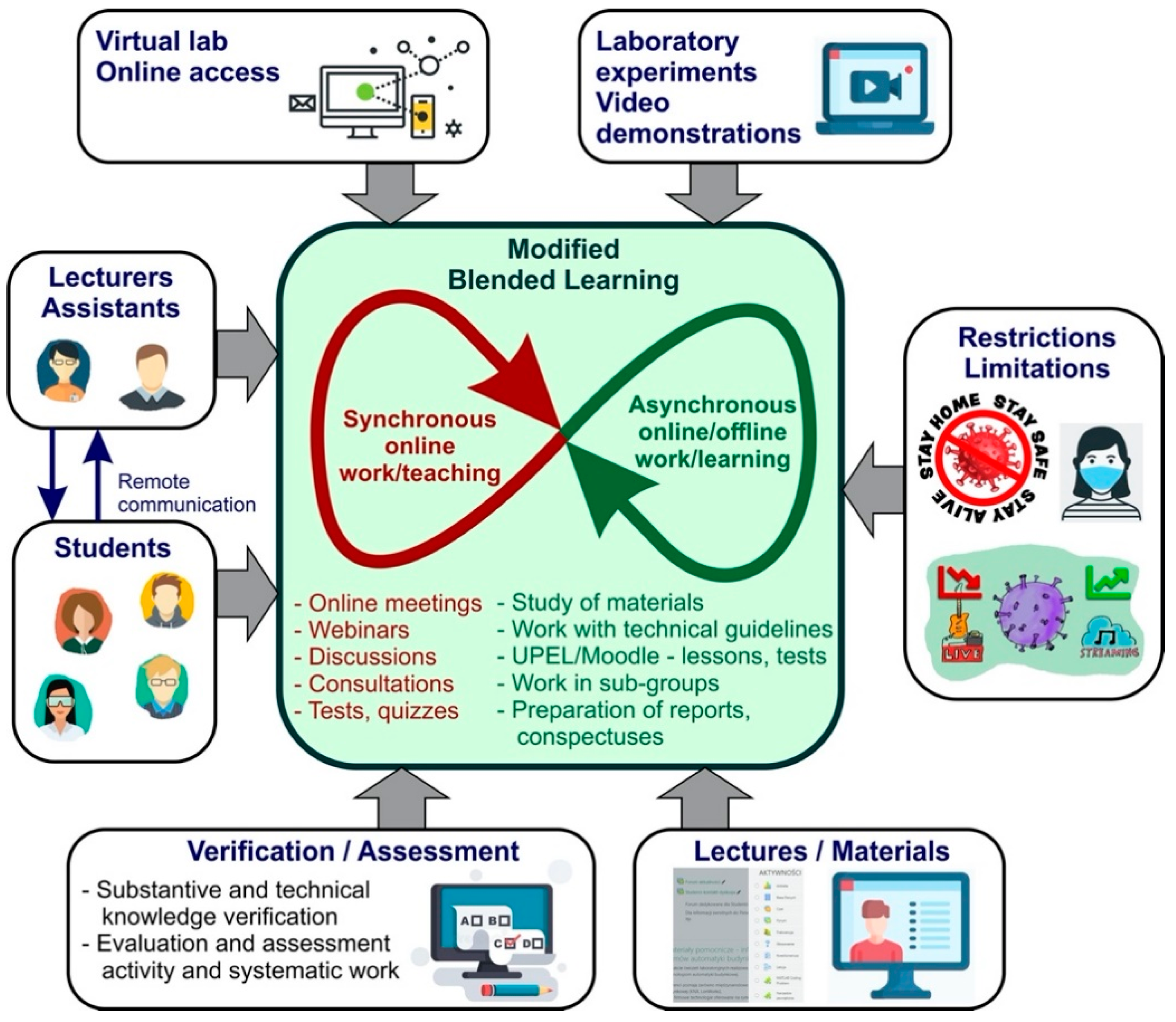

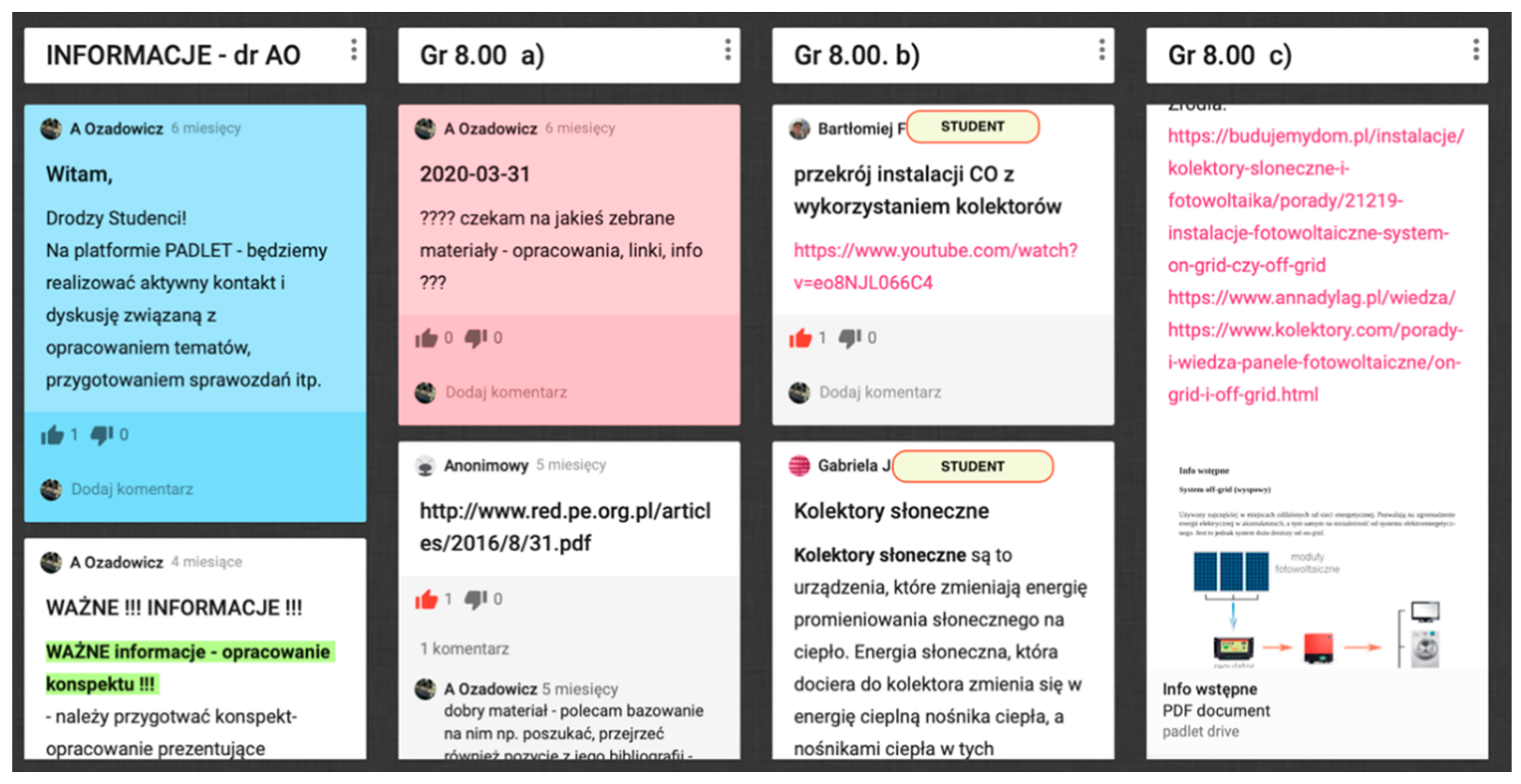
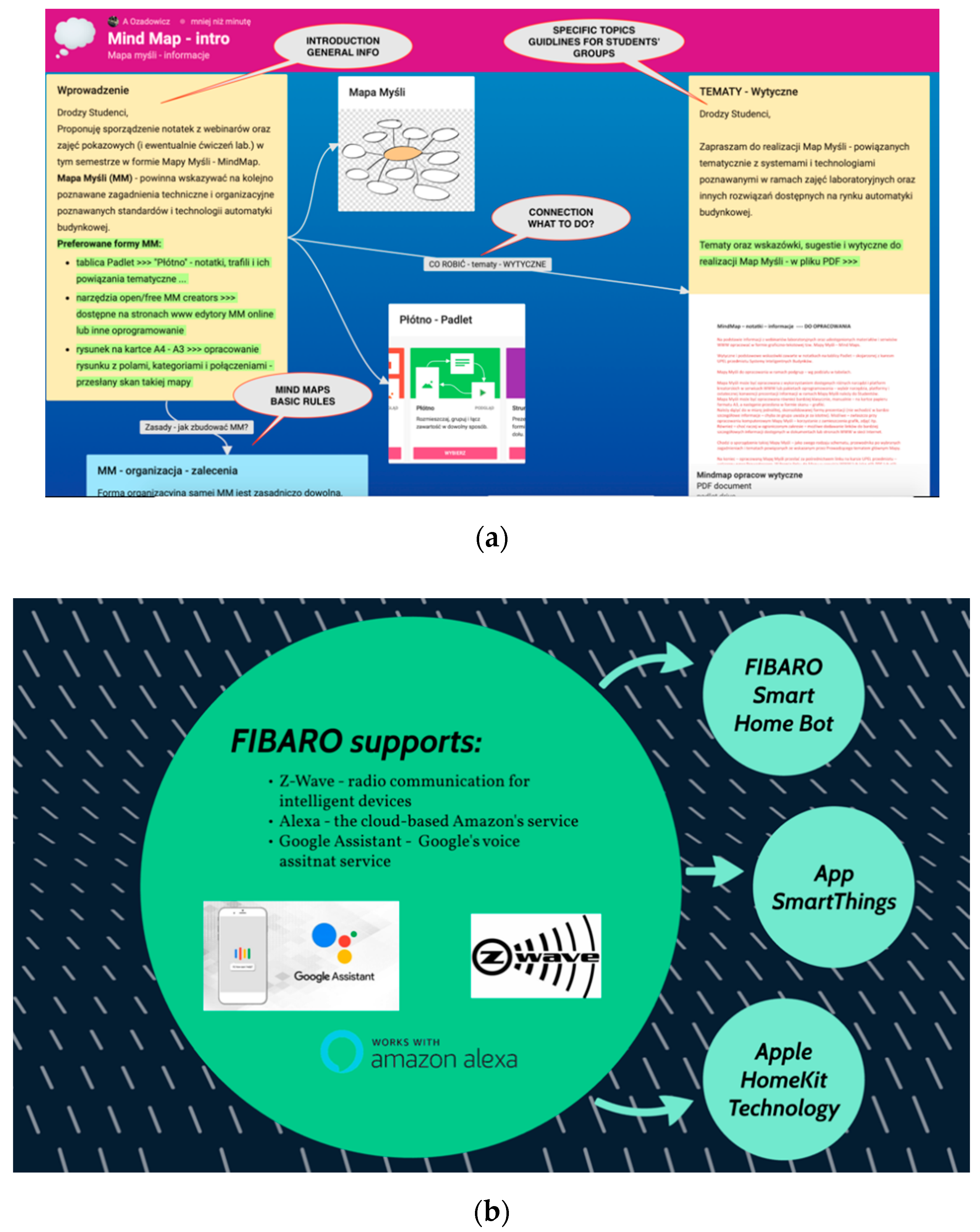
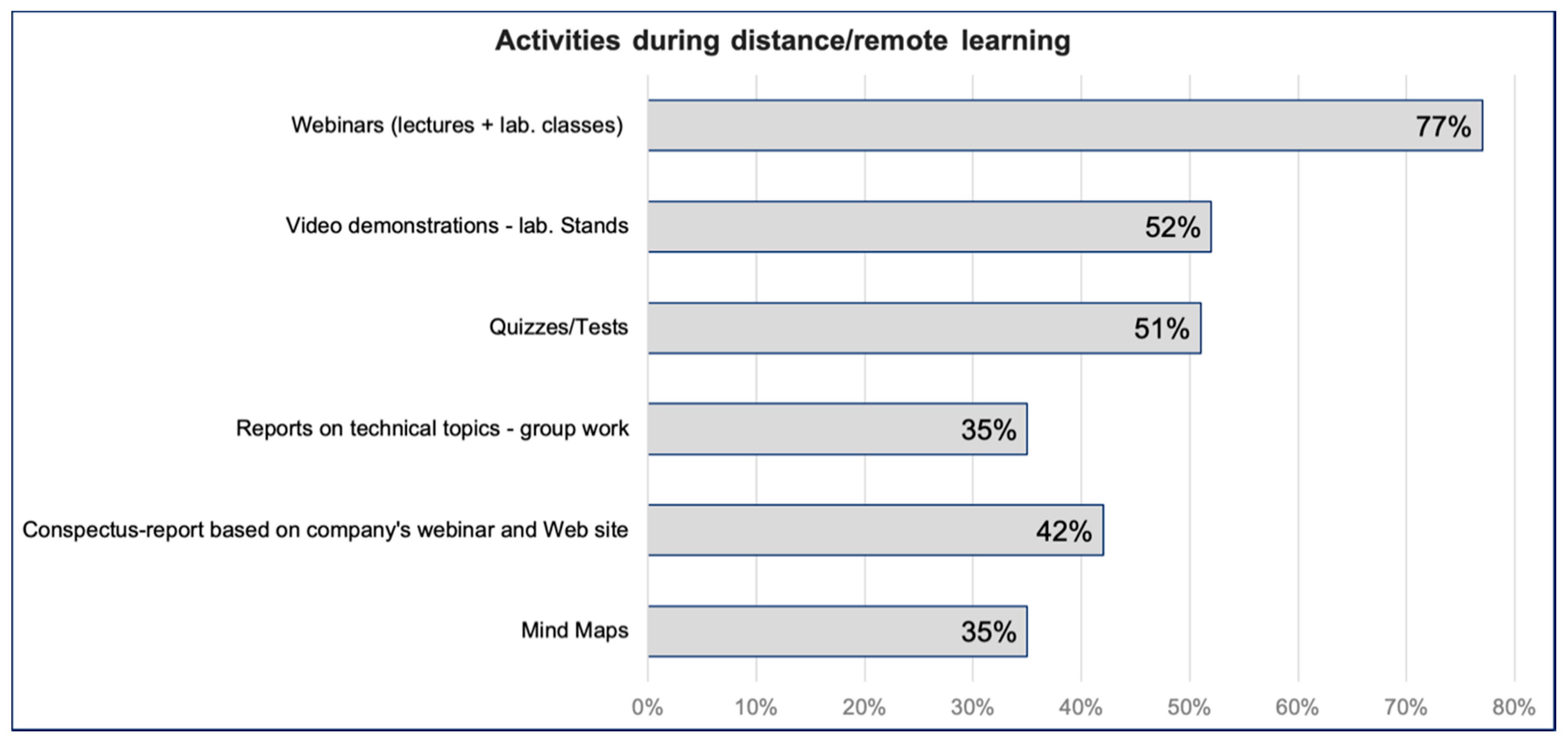
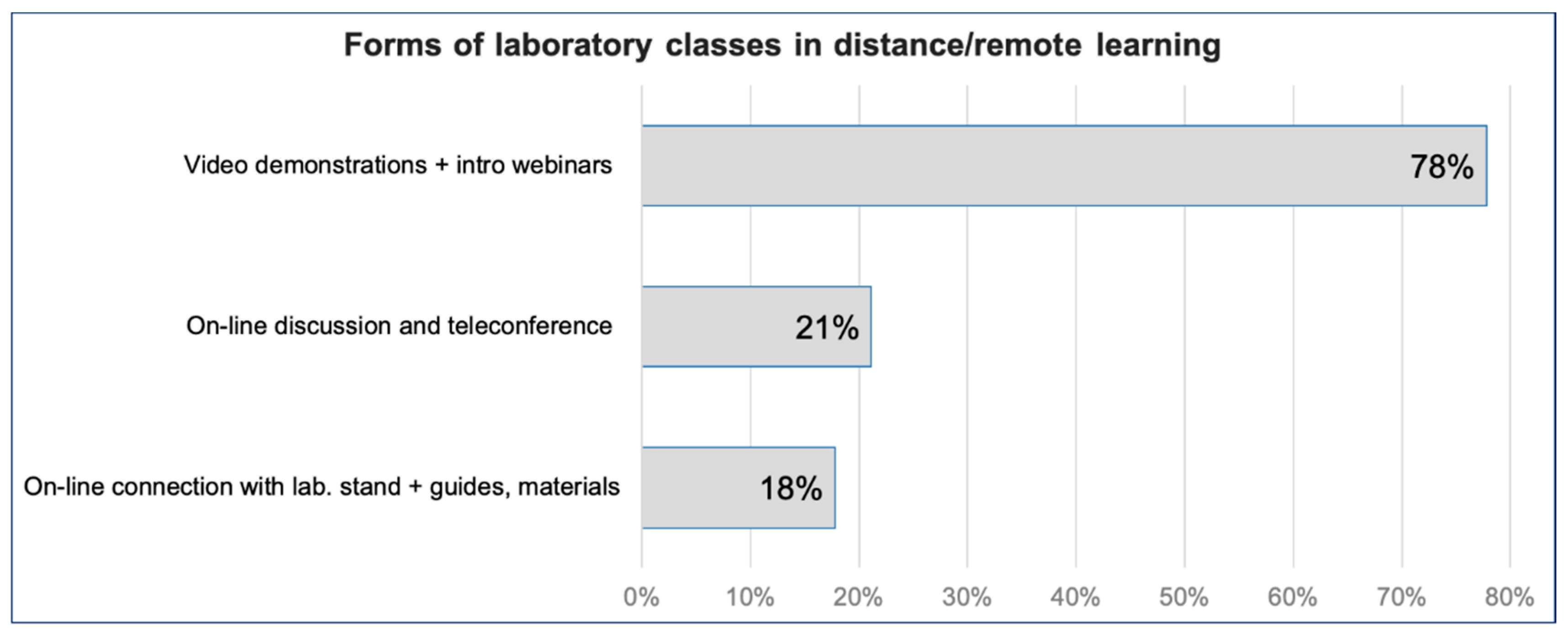
Publisher’s Note: MDPI stays neutral with regard to jurisdictional claims in published maps and institutional affiliations. |
© 2020 by the author. Licensee MDPI, Basel, Switzerland. This article is an open access article distributed under the terms and conditions of the Creative Commons Attribution (CC BY) license (http://creativecommons.org/licenses/by/4.0/).
Share and Cite
Ożadowicz, A. Modified Blended Learning in Engineering Higher Education during the COVID-19 Lockdown—Building Automation Courses Case Study. Educ. Sci. 2020, 10, 292. https://doi.org/10.3390/educsci10100292
Ożadowicz A. Modified Blended Learning in Engineering Higher Education during the COVID-19 Lockdown—Building Automation Courses Case Study. Education Sciences. 2020; 10(10):292. https://doi.org/10.3390/educsci10100292
Chicago/Turabian StyleOżadowicz, Andrzej. 2020. "Modified Blended Learning in Engineering Higher Education during the COVID-19 Lockdown—Building Automation Courses Case Study" Education Sciences 10, no. 10: 292. https://doi.org/10.3390/educsci10100292
APA StyleOżadowicz, A. (2020). Modified Blended Learning in Engineering Higher Education during the COVID-19 Lockdown—Building Automation Courses Case Study. Education Sciences, 10(10), 292. https://doi.org/10.3390/educsci10100292




